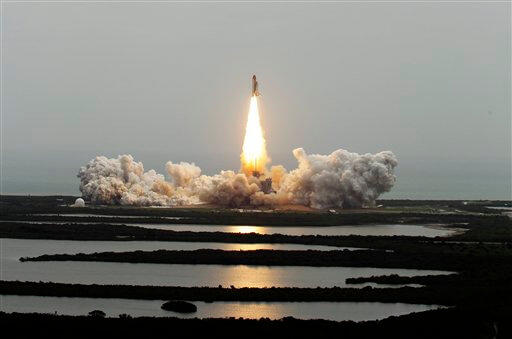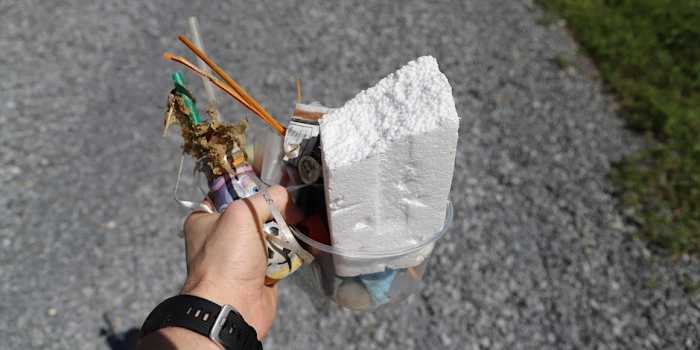
Atlantis and four astronauts rocketed into orbit Friday on NASA’s last space shuttle voyage, dodging bad weather and delighting hundreds of thousands of spectators on hand to witness the end of an era.
It will be at least three years — possibly five or more — before astronauts launch again from U.S. soil, and so this final journey of the shuttle era packed in crowds and roused emotions on a scale not seen since the Apollo moon shots.
After days of gloomy forecasts full of rain and heavy cloud cover, the spaceship lifted off at 11:29 a.m. — just 2½ minutes late — thundering away on the 135th shuttle mission 30 years and three months after the very first flight. The four experienced space fliers rode Atlantis from the same pad used more than a generation ago by the Apollo astronauts.
The shuttle was visible for 42 seconds before disappearing into the clouds.
NASA waived its own weather rules to allow the liftoff to go forward. In the end, though, the countdown was delayed not by the weather but by the need to verify that the launch pad support equipment was retracted all the way.
The crew will deliver a year’s worth of critical supplies to the International Space Station and return with as much trash as possible. Atlantis is scheduled to come home on June 20 after 12 days in orbit.
Before taking flight, Commander Christopher Ferguson saluted all those who contributed over the years to the shuttle program.
“The shuttle is always going to be a reflection of what a great nation can do when it dares to be bold and commits to follow through,” he said, addressing NASA launch director Mike Leinbach. “We’re not ending the journey today … we’re completing a chapter of a journey that will never end.”
He added: “Let’s light this fire one more time, Mike, and witness this great nation at its best.”
It wasn’t clear until the final moments of the countdown that the launch would come off. That was fitting in a way, since Florida’s famously stormy weather delayed numerous shuttle missions almost from the start of the program and was a major reason spaceflight never became routine, as NASA had hoped for.
Hundreds of thousands of spectators jammed Cape Canaveral and surrounding towns for the emotional farewell. Kennedy Space Center itself was packed with shuttle workers, astronauts and 45,000 invited guests, the maximum allowed.
NASA’s original shuttle pilot, Robert Crippen, now 73, was among the VIPs. He flew Columbia, along with Apollo 16 moonwalker John Young, on the inaugural test flight in 1981.
Other notables on the guest list: a dozen members of Congress, Cabinet members, the chairman of the Joint Chiefs of Staff, four Kennedy family members, Jimmy Buffett, Gloria Estefan and two former NASA chiefs.
The space shuttle was conceived even as the moon landings were under way, deemed essential for building a permanent space station. NASA brashly promised 50 flights a year — in other words, routine trips into space — and affordable service.
But the program suffered two tragic accidents that killed 14 astronauts and destroyed two shuttles, Challenger in 1986 and Columbia in 2003. NASA never managed more than nine flights in a single year. And the total tab was $196 billion, or $1.45 billion a flight.
Yet there have been some indisputable payoffs: The International Space Station would not exist if it were not for the shuttles, and the Hubble Space Telescope, thanks to repeated tuneups by astronauts, would be a blurry eye in the sky instead of the world’s finest cosmic photographer.
The station is essentially completed, and thus the shuttle’s original purpose accomplished. NASA says it is sacrificing the shuttles because there is not enough money to keep the expensive fleet going if the space agency is to aim for asteroids and Mars.
Thousands of shuttle workers will be laid off within days of Atlantis’ return, on top of the thousands who already have lost their jobs. And the three remaining shuttles will become museum pieces.
This day of reckoning has been coming since 2004, a year after the Columbia tragedy, when President George W. Bush announced the retirement of the shuttle and put NASA on a course back to the moon. President Barack Obama canceled the back-to-the-moon program in favor of trips to an asteroid and Mars.
But NASA has yet to work out the details of how it intends to get there, and has not even settled on a spacecraft design.
The space shuttle demonstrates America’s leadership in space, and “for us to abandon that in favor of nothing is a mistake of strategic proportions,” lamented former NASA Administrator Michael Griffin, who led the agency from 2005 to 2008.
After Atlantis’ lights-out, 33rd flight, private rocket companies will take over the job of hauling supplies and astronauts to the space station. The first supply run is targeted for later this year, while the first trip with astronauts is projected to be years away.
Until those flights are up and running, American astronauts will be hitching rides to and from the space station via Russian Soyuz capsules, at more than $50 million per trip.
Russia will supply the rescue vessels for Ferguson and his crew if Atlantis ends up severely damaged in flight. But the Russian spaceships can carry only three people, including two crew members, and any rescue would require a series of back-and-forth trips. That is why only four astronauts are flying Atlantis, the smallest crew in decades.
That reliance on Russia — with no other backup — has many space veterans worried. A contingent of old-time flight directors and astronauts, Crippen included, is seeking a last-ditch reprieve for the space shuttle, at least until something is ready to take its place.
Crippen acknowledged it is futile at this point.
“I’m afraid that ship has sailed,” he said on the eve of the launch. But noting the improvements that had been made in the shuttles over the past three decades, he said: “Those vehicles, in my opinion, could fly for another 30 years and could be flown safely.”
This last journey by Atlantis may be stretched to 13 days if enough power can be conserved. Weather permitting, Atlantis will return to Kennedy, where it will be put on public display. Discovery and Endeavour already are retired and being prepped for museums across the country.
___
Online:
NASA: http://1.usa.gov/9JytXVNASA:
Copyright 2011 The Associated Press.
































